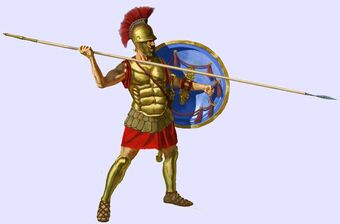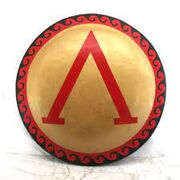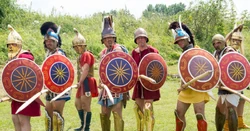
Here you can get a good look at how an Aspis looked like on the inside.
The Aspi, commonly mistaken for (Hoplon) is a large round shield used in Ancient Greece. It was the Weapon of the Spartans.
Description[]
The shield was made of several layers of wood covered in a layer of bronze with a layer of leather in between, to absorb shock. The shield had a strap in the middle of the shield and a handle at the right edge. A cloth would sometimes be placed on the shield to absorb arrows that attempted to strike under the shield.
The shield was usually decorated with an emblem; the lambda (a Greek letter equivalent to L) being the most well-known, was for Spartan hoplites. (In Greek, the Spartans were known as "Laodiceans.") Thebian Hoplites had a club as their national icon. The Athenians normally had their own unique painting for each individual. It was common for hoplites to draw beasts mythical animals on the shields. Athenians stopped this practice after the Battle of Delium 424BC; Athenian Hoplites became confused by the lack of unity among the shield icons, causing confusion and friendly fire (arguably the first recorded incidence of friendly fire in warfare).
Stats[]
- 40" diameter
- 24 lbs
- Wood coated with Bronze
Uses[]
In Greek warfare, the aspis was the most important piece of equipment of the hoplite (heavy infantry). Its large size covered a large portion of the holder's body and its weight (24 lbs in the show) allowed it to deliver crushing blows. Vital to maintaining the effectiveness of the Greek phalanx, the left third of the shield would protect the right flank of the man to the holder's left, hence why losing it was considered to be a disgrace.
After the battle, the aspis was often used as a stretcher to carry the dead and wounded from the battlefield. In the event of a retreat, the shield would usually be the first thing discarded. These two facts gave birth to the phrase "Come back with your shield or on it." which Spartan women told their husbands when they left for battle. In Sparta, a routing soldier most likely was disgraced and executed for cowardliness.

Outside of the Shield.
In the Series[]
The Spartans used his Aspis in the simulations to great effect, protecting himself from the deadly projectile attacks of the Ninja and the crushing blows of the Samurai's kanabo, while also using it offensively to bash and throw around both opponents. It was the most devastating weapon against the unarmored Ninja and was still effective against the Samurai in terms of kills, but had significantly less kills most likely to the Samurai's heavy armor.
Pelta[]
Unlike the Spartans; the Macedonians were imperialistic and thus had to invade enemy territory. Spartan shields were massive because Spartans specialized in defenses and armor. Philip II introduced lighter gear to his Phalangite hoplites in order to give them more mobility. The smaller shield also allowed for tighter formations. Xyston and Sarissa spears were so heavy that the Phalangite attached the Pelta to their arm so that they didn't need to use their hands.

Macedonian soldiers with Pelta Shields